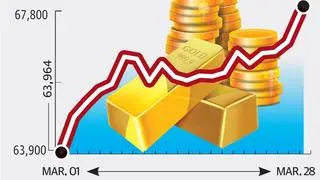Gold prices plummeted again this week, closing at $1133.6/ounce, down 2.3 per cent. Data on Thursday showed that the US recorded a robust 3.7 per cent growth in GDP in the second quarter, higher than the estimate of 2.3 per cent. Silver and platinum too closed in the red at $14.5/ounce and $1,018/ounce respectively.
Strong US data has revived expectations among investors that the Federal Reserve may ignore problems in China and go ahead with a rate hike at its upcoming meeting in September. Given that gold is a non-interest bearing asset, the belief is that it will lose out in a rising rate environment, the reason why the metal was beaten down last week. BusinessLine evaluated the behaviour of gold prices after previous Fed rate hikes to find out if it works in practice.
Actually, it doesn’t. Though gold prices typically drop in the run-up to a rate hike cycle, they tend to bounce back once the first hike in the cycle is over. Similarly, while the dollar usually appreciates as the Fed prepares for a rate hike, it weakens after rates start to move up. This was true of the last three Fed rate hike cycles.
In 1994, the Fed funds rate rose from 3.5 per cent to 6 per cent between February and September. Gold started rising two months into the up-cycle in April, and by September had recorded a 4.5 per cent gain. The US dollar index, hovering at 94-95 in February, dropped to 87.8 by December.
Similarly, in 1999, when the Fed started a hiking cycle in July, gold — initially seen losing sheen — scaled up after the second rate hike. The dollar, which was moving up in the six months preceding the rate hike, plummeted after the first hike. Again, in June 2004, when the Fed funds rate soared by 100 points between June and December to 2.25 per cent, gold rallied 11 per cent and the US dollar index lost 9 per cent. So, if history does repeat itself, investors should expect gold prices to edge up as the Fed rate cycle begins. Expect the dollar to lose muscle in this period.
Short termDespite this, gold prices may face headwinds in the short term from a strong dollar. The charts show that if the $1,165-1,170 level is not breached in the next one or two weeks, which is a 38.2 per cent retracement of the move from January to July, the metal may fall to $1,098 and head to $1,077 — the July low.
This week, the US PMI manufacturing index for August will be released on Tuesday, followed by the weekly jobless claims number on Thursday and crucial employment data on Friday. Non-farm payrolls are expected to have risen to 223,000 in August, from 215,000 in July, and the unemployment rate is pegged marginally lower.
Currency gambleFor Indian investors, trading on gold will be largely a gamble on the rupee. The currency hit 66.76 against the dollar early last week, but gathered steam to close at 66.125. But given that the equity market is volatile now, there can be currency swings in the short term.
MCX gold closed at ₹26,623, down by 2.3 per cent, to exactly match the movements of gold in the international market. Investors who have been riding the upmove for the last two weeks may have booked profits. Though the contract was successful in breaching the resistance at ₹27,500, it couldn’t get past our target of ₹28,200.
This week, the contract may hover between ₹27,000 and ₹28,000. But any appreciation in the rupee or a weakness in global gold prices can take it down to ₹26,100 and ₹25,700.
The MCX Silver contract has been weak, in tune with international prices of silver with strong industrial demand for the metal.
It closed last week at ₹34,378, down 5 per cent. In the coming sessions, it may dip further to ₹33,200 and ₹32,700. However, if it gains momentum, it can move up to test the resistance at ₹36,000 level.








Comments
Comments have to be in English, and in full sentences. They cannot be abusive or personal. Please abide by our community guidelines for posting your comments.
We have migrated to a new commenting platform. If you are already a registered user of TheHindu Businessline and logged in, you may continue to engage with our articles. If you do not have an account please register and login to post comments. Users can access their older comments by logging into their accounts on Vuukle.